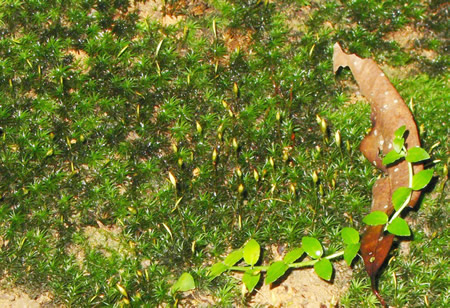Mosses 蘚 (Bryophyta)
The gametophyte of mosses is typically leafy with multicellular rhizoids. Numerous chloroplasts can be found in most cells. The sporophyte is usually small, unbranched and nutritionally dependent on gametophyte, like the one in other bryophytes. It often differentiates into foot, seta, and sporangium. Leptoids and non-lignified hydroids, the conducting tissues, can be found in some species in the gametophytic or/and sporophytic phase(s).
Here we will explore two of the well-known genera of mosses, Polytrichum and Sphagnum.
Polytrichum, a member of Polytrichaceae, is a cosmopolitan genus . The gametophytes of Polytrichum grow in patches, forming “miniature forests” on the ground in woods, moors, heaths, etc. Above the rhizome-like underground stem are erect shoots. A cross-section of the aerial stem shows the conducting tissues, hydrom and leptom, though Polytrichum is a non-vascular plant. After fertilization, a young sporophyte is growing from the shoot tip of the mother gametophyte. The mature sporophyte is differentiated into a capsule covered by a hairy calyptra, a long seta and a foot. Since Polytrichum is rarely found in Hong Kong, we will use live-specimen photos of Pogonatum, a common local species of the same family, to illustrate some common morphological features of Polytrichaceae.

Sphagnum is one of the most abundant plants in the world and they are commonly found in wet area like extensive bog regions of Northern Hemisphere. The gametophyte is leafy and the leaf cells are dimorphic: the large colorless barrel-shaped hyaline cells with pits and spiral thickenings on their walls surrounded by the long, narrow photosynthetic cells. The main stem contains the central cylinder and cortex with no conducting tissues. Its sporophyte is elevated on a long pseudopodium into the air, and is differentiated into the foot, the seta and the capsule.
